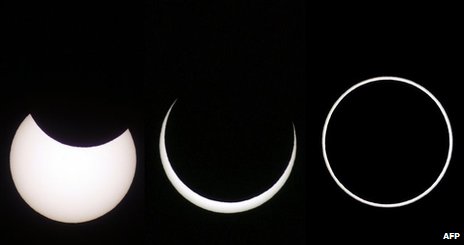
Men and women from the Turkana tribe in Kenya took part in a ceremony ahead of the eclipse
A rare solar eclipse allowing a view of the Sun that is totally or partially blocked out by the Moon has begun.
It is first visible in the southern United States, and is moving east, The best view of the total eclipse on land will be in Gabon at about 13:50 GMT.
The total eclipse will then sweep east across the African continent. Partial views will be available in eastern North America and southern Europe.
Experts warn that no-one should attempt to view the Sun with the naked eye.
A safe view of eclipses can be obtained by using special welder’s glasses or a pinhole camera.
Halo
This solar eclipse is a rare occurrence in that it is “hybrid” – switching between an annular and total eclipse.
In a total eclipse, the Moon completely covers the sun, while an annular eclipse occurs when the Moon is at its farthest from the Earth and does not block out the Sun completely, leaving a halo of sunlight still visible around the Moon.
The eclipse event was due to begin about 1,000km (620 miles) east of Jacksonville, Florida with an annular eclipse visible for four seconds at sunrise (11:05 GMT), Nasa said.
As the Moon’s shadow races east the eclipse will switch from annular to total along a narrow corridor. Greatest total eclipse will occur in the Atlantic Ocean at 12:47 GMT, approximately 330km south-west of Liberia, for more than one minute.
On land, the best total eclipse will be visible in Gabon.
“The eclipse will then continue across Africa through the Congos until it passes through northern Uganda and northern Kenya, ending in southern Ethiopia and Somalia,” said the International Astronomical Union.
Either side, a partial eclipse will be seen within a much broader path including eastern North America, northern South America, southern Europe, the Middle East and Africa.

An annular eclipse is when the Moon is too far away to cover the Sun completely, and retains a fiery halo - such as here in Portugal in 2005
Eclipse safety
- Looking directly at the sun during a partial or annular eclipse, or the partial phases of a total solar eclipse, can can cause temporary or permanent damage to the retina
- Special welder’s glasses or mylar lenses manufactured especially for viewing solar eclipses are recommended
- Or you can make a pinhole camera by making a 3mm hole in a sheet of paper, turning your back to the Sun and using the pierced page to project the image of the Sun on to another sheet of paper



Leave a reply